Introduction and Purpose of Numbering the Companies of the German Reich:
Table of Contents:
- Introduction of the Reichsbetriebsnummer
- Description and Structure of the Reichsbetriebsnummer
- Implementation of Numbering the Companies of the German Reich
- Use of the RBNr. as a Maker Marking
- Reference
Introduction of the Reichsbetriebsnummer:
The introduction of the Reichbetriebsnummer was one of the measures taken by the Reichsminister für Bewaffnung und Munition which was carried out on the basis of a Führerbefehl to simplify and standardize reporting.
It should facilitate correspondence between companies and the authorities as well as the other business transactions of companies and ensure significant labor savings.
By numbering each company with a unique sequence of numbers, it was possible to create a so-called Stammkarte in the form of machine-readable punch cards for each individual company. These cards contained important information from the individual companies for the various authorities, especially for the Ministry of Armaments. Among other things, they contained information on belonging to the individual economic groups or guilds, employment office and the number of employees. Based on this information on a punch card system, it was easily possible to read out the required data and sort it by machine, depending on the statistical purpose. Since the various authorities operating in the German Reich were able to access this information quickly through the possibility of machine reading, a large part of the previously occurring correspondence between the authorities and companies was unnecessary.
According to the decree of the Reichsminister für Bewaffnung und Munition 120/BIII – 13 J/Le (1) of June 2nd 1942, a numbering of companies of the Reich was to put into practice for the purpose of simplifying reporting.
Description and Structure of the Reichsbetriebsnummer:
In the above-mentioned decree, it was stipulated that the number, at that time still referred to as Reichsfirmennummer (short: RF-Nr.), is a number that is structured as follows:
- a single-digit digit that indicates belonging to the individual Groups of the Reich
- a district code (up to four digits) that indicates the geographical location of the company
- a serial number (up to four digits) that identifies the company itself
Contrary to this official order, in correspondence between authorities, chambers and individual companies, the Reichsfirmennummer was repeatedly called Reichsbetriebsnummer. This led to disagreements among the companies as well as their chambers of commerce and industry about the name that actually was to be used.
A letter from the Reich Chamber of Commerce III 320/42 (1),of Sep. 16th 1942, to the Chamber of Industry and Crafts shows that the term Reichsfirmennummer is no longer used and that in the future the term Reichsbetriebsnummer (abbreviated: RB-Nr.)is to be used instead.
The companies were informed about the renaming by the Reichsgruppe Industrie or by its Wirtschaftsgruppen.
Furthermore, this letter also explained that the Reichsbetriebsnummer should be visible in letterheads and that the abbreviation "RB-Nr." should be used for the impression in the business papers or when making stamps.
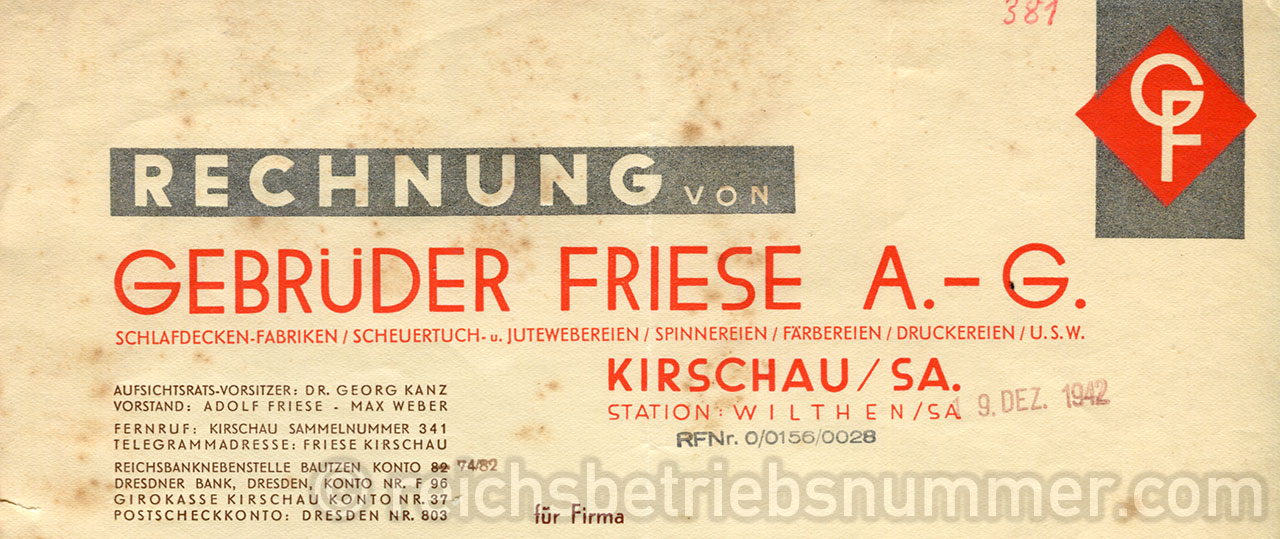
On this invoice head of the company Gebrüder Friese AG from December 1942, we see the RFNr. 0/0156/0028, which was subsequently applied by stamps.
The term Reichsfirmennummer was still used, although it was already declared obsolete in September 1942 and Reichsbetriebsnummer was determined as the correct designation. Stamped invoice heads are often found and it can be assumed that many companies have purchased the forms in stock and the remaining stocks have been used up.
The requirement to include the Reichsbetriebsnummer in correspondence was then implemented by subsequently stamping these forms.
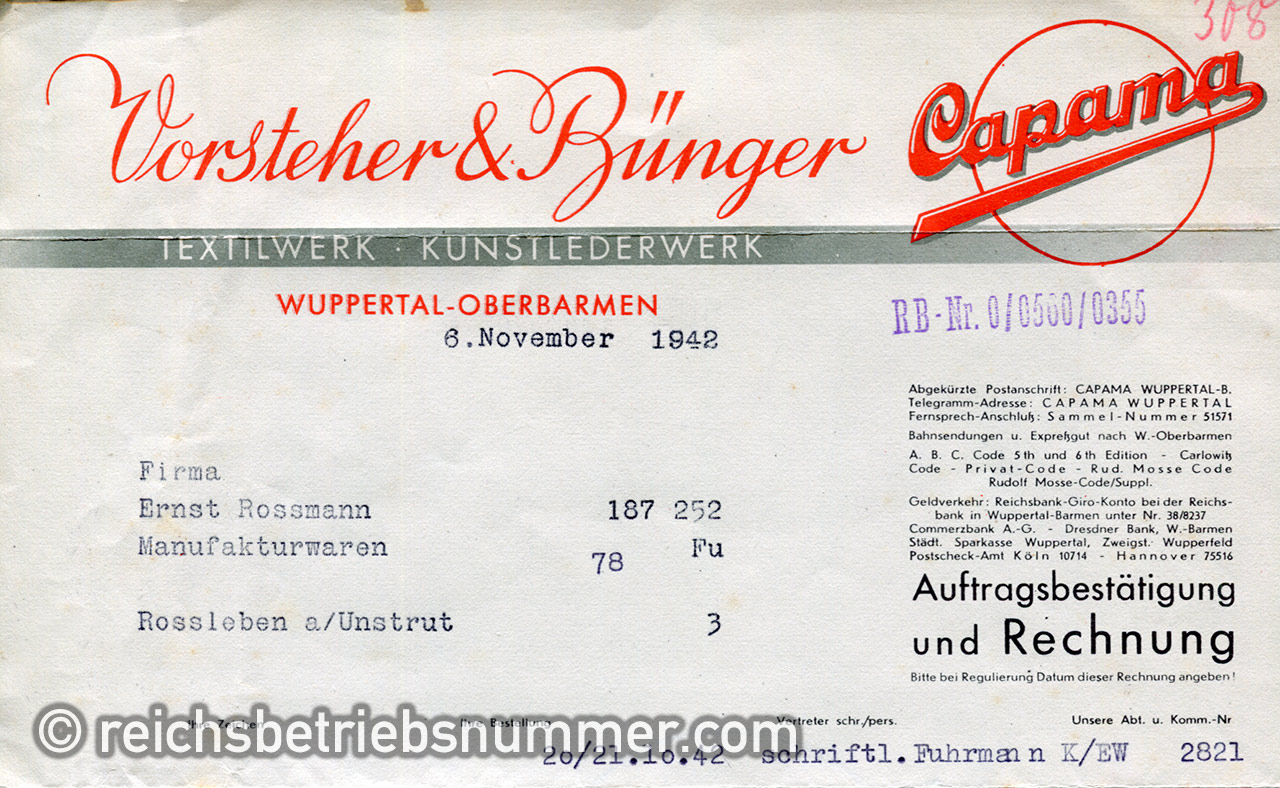
On this invoice head of the company Vorsteher & Bünger from November 1942, we see the RBNr. 0/0560/0355. which was subsequently applied by stamp. Here already correctly referred to as the Reichsbetriebsnummer.
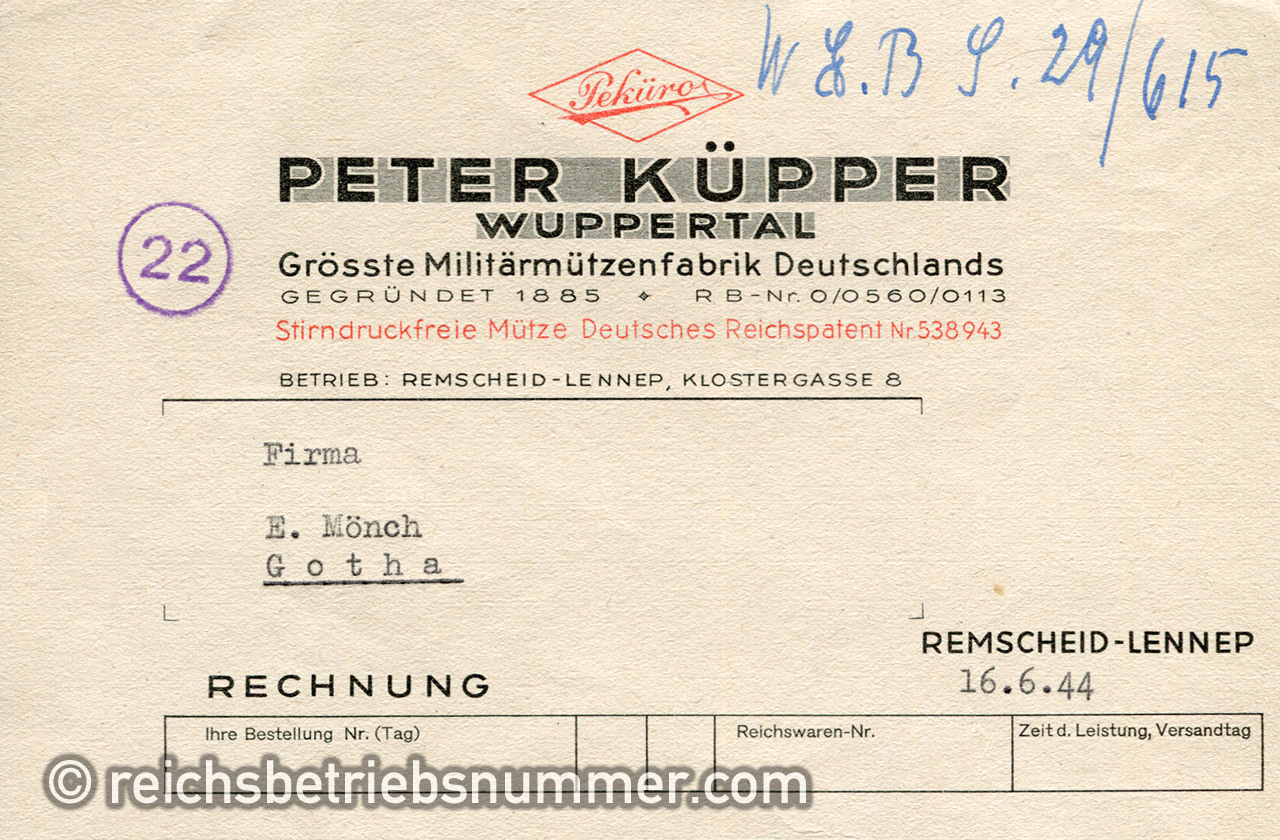
In the 1944 invoice of the Küpper military cap factory, the Reichsbetriebsnummer 0/0560/0113 was included in the head of the invoice form.
The number is composed as follows:
e.g.:
In the decree of June 1942, the district code and the serial number were still described as up to four digits. In the various sources with lists of companies, there are some RBNrs. that are not 9 digits, but in which preceding zeros of the district code or serial number were probably omitted because of this initial formulation. The affected blocks were only three digits long.
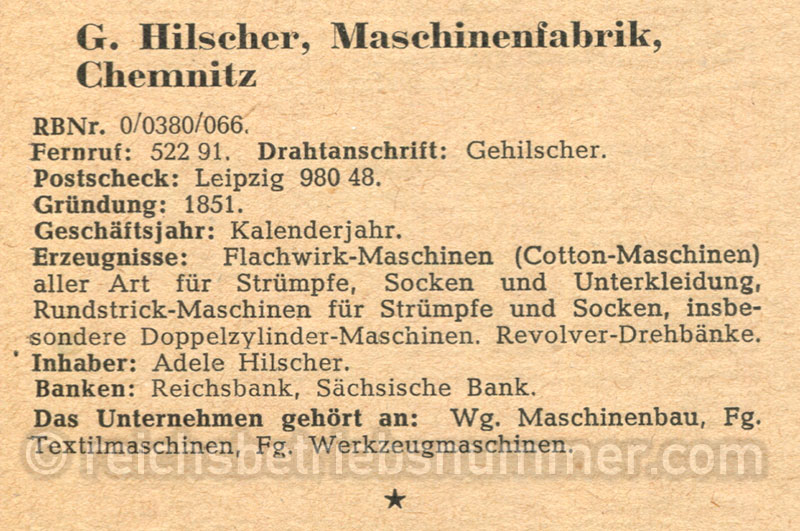
In this entry in the Handbuch der großen GmbH., KG., OHG. und Einzelfirmen, edition 1944 of the company G. Hilscher from Chemnitz, the RBNr. 0/0380/066 (5) is indicated. In this example, the numeric block of the serial number of the company is only 3 digits long. Since such cases are relatively common, I do not assume a misprint. It can be assumed that individual companies deliberately used shortened RBNrs. since the structure of the RBNr. was not clearly defined in the first decrees. In the case of the company G. Hilscher, in addition to the entry in the GmbH book, there is also a index card in the Reichbetriebskartei. On this, the RBNr. is entered in correct spelling with four digits 0/0380/0066 (6).
In later, adapted decrees, the wording "up to" was omitted and the district code and the serial number were only displayed as a four-digit number. In a circular of the Wirtschaftsgruppe Elektrizitätsversorgung W.E.V. 209/42 (BW) (2) of Dec. 10th 1942, for example, the structure of the Reichsbetriebsnummer was described very precisely as follows:
Quotation translated from German to English:
"The Reichsbetriebsnummer (RBNr.) is a nine-digit number whose first digit represents the identification number of the Reichsgruppe. The first digit is followed, interrupted by a slash, by a four-digit number for the city or district. The last four-digit number, also separated by slash from the previous one, continuously includes the companies of the district designated with the previous digits and the Group of the Reich."
On the field postcard used by default by the Inspections of Armament (Rüstungsinspektionen) to transmit the assigned RBNr. it was also explicitly stated that the number must always be advertised with all nine digits.
No. of the Reich Group (Nr. der Reichsgruppe): 0/0000/0000
The numbers of the various groups were set out in Appendix 2a of decree 120/BIII – 13 J/Le (1), as follows:
0 Industry (Reichsgruppe Industrie)
1 Trade (Reichsgruppe Handwerk)
2 Commerce (Reichsgruppe Handel)
3 Banking (Reichsgruppe Banken)
4 Insurances (Reichsgr. Versicherungen)
5 Power Economy (Reichsgr. Energiewirtschaft)
6 Tourism (Reichsgr. Fremdenverkehr)
7 Traffic (Reichsgruppe Verkehr)
8 Food Industry (Reichsnährstand)
9 open (offen)
District Code (Kreiskennziffer): 0/0000/0000
The district code indicates the geographical location of the company. All districts were counted as the lowest administrative authority.
A more detailed explanation can be found in the chapter District Codes.
Serial Number (Laufende Betriebsnummer): 0/0000/0000
Initially, the numbering was only carried out for companies in the area of the Reichsgruppe Industrie.
Previously issued by the OKW (Oberkommando der Wehrmacht) or the Inspections of Armament
(Rüstungsinspektionen), the Wehrmachtfirmennummer, which had already been given out to all companies that are
important for defense regardless of their affiliation to an Group of the Reich, was taken over as the serial
number.
In order to be able to accept new companies during the transitional period, new firms without
Wehrmachtfirmennummer received serial numbers from 5001.
Implementation of Numbering the Companies of the German Reich:
It should be noted that the documents found in the various archives so far, can only be described as fragmentary correspondence between different authorities and companies. The overall implementation of the Reich company numbering and the resulting requirements can only be explained in part.
To make matters worse, some correspondence suggests that the various authorities commissioned with the implementation of the numbering (e.g. Rüstungsinspektionen [Inspections of Armament], Landeswirtschaftsämter [State Economic Offices] and Industrieabteilungen der Wirtschaftskammern [Industrial Departments of the Chambers of Commerce]), interpreted the instructions for the numbering that were given by the office of the Maschinelles Berichtswesen (Machine Reporting section of the office of Reichsminister für Bewaffnung und Munition) differently. Therefore there were significant regional deviations in the allocation of the Reichsbetriebsnummer to the companies.
In order to enable a coherent approach to the numbering process at all, formulations had to be constantly refined and solutions defined for the increasingly occurring problems with the allocation of numbers over time.
The first decree of the Reichsministers für Bewaffnung und Munition showed that all companies in the German Reich should receive an Reichsfirmennummer. In addition, the order defines more precisely the term "Betrieb", on the basis of which it was necessary to assess whether any ancillary companies or branches received a separate RBNr..
The Inspections of Armament (Rüstungsinspektionen) were held responsible for carrying out the numbering. These should number on the basis of the available address material of the Industrial Departments of the Chambers of Commerce (Industrieabteilungen der Wirtschaftskammern). After the already existing files were also coordinated with the State Economic Offices (Industrieabteilungen der Wirtschaftskammern), a field postcard according to a certain model was issued for each company, which had to be sent from 01.08.1942. These cards had a separable part on which the data to be recorded in the Stammkarte of the company was queried and had to be sent by the company as a response to the responsible Inspections of Armament (Rüstungsinspektion).
After re-entry at the Inspections of Armament, the punch cards referred to as Stammkarte were created on the basis of the information provided by the companies on the card.
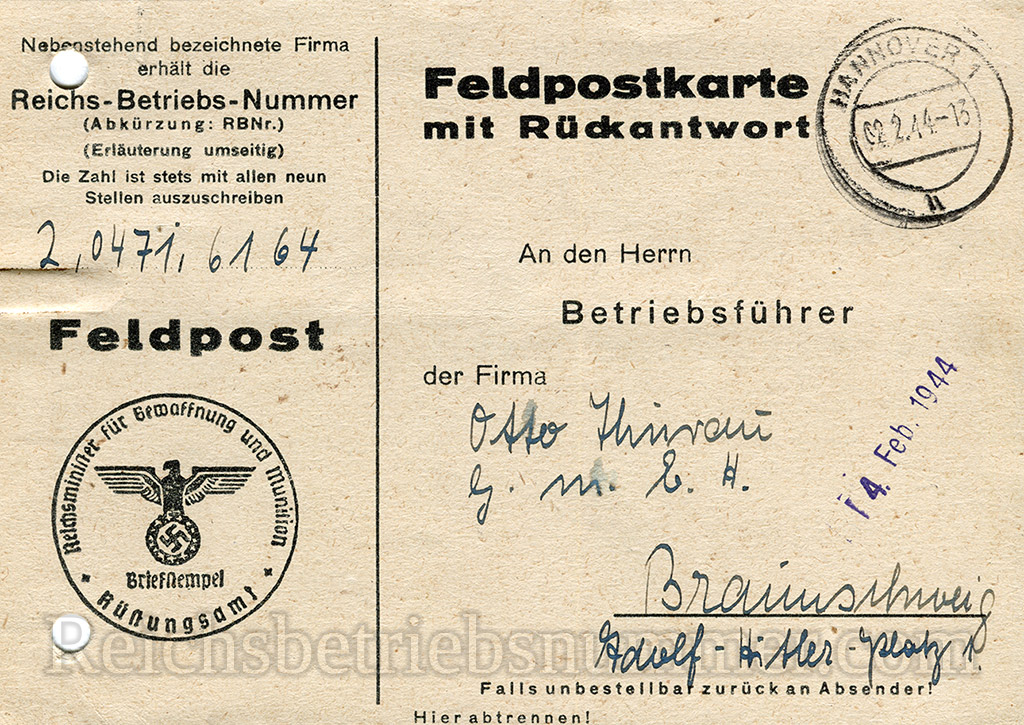
With such field postcards, the individual companies were informed about the Reichsbetriebsnummer assigned to them.
On this original received card, with which RBNr. 2/0471/6164 was assigned to the company "Otto Thurau G.m.b.H." based in Braunschweig, the separable part that was sent back to the Inspections of Armament is missing.
Succession of the Numbering:
Already on Jul. 23rd 1942, a letter from the Reichsminister für Bewaffnung und Munition Rüstungsamt/Rü MB
III (1) made it clear that initially the numbering was only ordered for the Reichsgruppe
Industrie.
However, it can be assumed that this progressed relatively quickly and immediately the numbering of
companies
outside the Reichsgruppe Industrie began. For example, in the letter of the
Wirtschaftsgruppe Elektrizitätsversorgung W.E.V. 209/42 (BW) (2)of
Dec. 10th 1942 it is to read that the companies of the Reichsgruppe Industrie have now received their RBNr.
and that the RBNrs. have already been given to the utilities of the Reichsgruppe Energiewirtschaft.
By order of the Inspections of Armament of the Reichsminister für Bewaffnung und Munition Az. 13s30/MB/3 (3) of Feb. 23rd 1943, the numbering in the construction industry was ordered. This included all construction companies and craft businesses in the construction, roofing, glazing and painting trade. One-man businesses remained excluded.
A letter from the Chambers of Commerce (Reichswirtschaftskammer) III 89/43 (1) dated Mar. 29th 1943 describes that the numbering was introduced not only to the Reichsgruppe Industrie and Energiewirtschaft but also for the Reichsgruppe Handwerk.
In an order of the Maschinelles Berichtwesen Az. 69 MB (III,7) (4) of Jun. 25th 1943, it was explained that during the war only companies for which there is an armanents need will be recorded. Except for the Reichsgruppe Industrie, which should be fully recorded.
It is also clear from this order that the initially ordered allocation of company numbers greater than 5000 to new companies is no longer necessary for the areas of the Reichsgruppe Industrie and newly admitted industrially important companies may also be assigned free numbers under 5000.
Assignment of the companies to the corresponding groups:
Various correspondence indicates that incorrect assignments to the Reich Groups have often occurred during the allocation of the Reichsbetriebsnummer.
For example, the "Städtische Wasser-, Gas- und Elektrizitätswerke" of the city of Mannheim already received RBNr. 0/0667/5406 in 1942.
Even though the name of the company clearly indicates that its purpose is the supply of water, gas and electricity, it got a RBNr. with the Group Nr. 0 Industry.
In the letter from the Wirtschaftsgruppe Elektrizitätsversorgung W.E.V. 209/42 (BW) (2)from Dec. 10th 1942, the problem has already been addressed and it was explained that in ignorance of the situation, many numbers were given out incorrectly. It was only on Aug. 28th 1943 that the incorrectly issued number was corrected to 5/0667/5406 in accordance with the Reichsgruppe Energiewirtschaft (2) by sending a new field postcard.
Another example of incorrect assignment emerges from a correspondence of the company "Deutsch-Amerikanische Petroleum Gesellschaft" of Nov. 13th 1942 (8) with the office of the specialist subgroup mineral oil and mineral oil products. In this case, a total of 10 RBNrs. were assigned to the company with its various branch offices distributed across the German Reich. While some Inspections of Armament also assigned warehouses, loading points and workshops to the Reichsgruppe Industrie, other Inspections of Armament assigned them to the Reichsgruppe Handel, although these branch offices served the same purpose. For example, the Koblenz warehouse received RBNr. 0/0629/5226 (Reichsgruppe Industrie), but the Wesermünde warehouse received the 2/0414/0031 (Reichsgruppe Handel).
In this regard, too, in the order of the Maschinelles Berichtwesens Az. 69 MB (III,7) (4) of Jun. 25th 1943 extended information on the definition of a company and on assignment to the individual Reich groups has been provided.
There it says in point 3 of the order::
Quotation translated from German to English:
"A company within the meaning of these regulations is the local facility of the company.
a. In the area of the Reichsgruppe Industrie, the local facilitiy includes independent locally connected production facilities with the ancillary and auxiliary companies, warehousing including any central warehouses, central facilities (e.g. power central, etc.), administrations, even if this is supervised by administratively locally separated companies and facilities. Administrations, operating and sales organizations that are not locally connected to a company, e.g. central administrations, sales departments, etc., are considered independent companies.
b. In the area of the Reichsgruppe Handwerk: Any independent craft business that is registered in the craftsman's role. This also includes the state delivery cooperatives (Landeslieferungsgenossenschaften)."
For the groups Trade, Banking, Insurance, Energy, Tourism and Transport, this definition should still be announced, but there are no other documents available that revisit these groups.
Point 6 of the order describes in more detail the process for determining the group membership:
Quotation translated from German to English:
"Decisive for the assignment of a company to one or more Reich groups is the organized affiliation of the company. It is not the discretion of the MB offices (Maschinelles Berichtswesen) to make decisions on this. The determination of group membership must be done in cooperation with the industrial departments, craftsmen's or commercial department of the Chambers of Commerce or the responsible Reich Groups. If a company does not know its affiliation to an Reich Group, it must be required to determine it immediately in order to avoid a provisional number with the guide number 9.
Gravel and clay pits, quarries, etc. do not receive a separate number; in these cases, only the leading company receives a RBNr..
Self-employed master craftsmen in the cigar industry are also not to be numbered in the branch, but receive a uniform RB number per Gau and company. The district code of the district in which the company is represented with the most employees must be used.
In point 5, the handling of companies will be explained that belong to more than one group:
Quotation translated from German to English:
"When reassigning RBNrs., companies belonging to several Reich Groups receive an RBNr. with the leading number of the Reichsgruppe, which accounts for the majority of employees. In principle, the employment relationship at the time of the numbering must be used. Only in the case of seasonal operations must the maximum seasonal level of the individual parts of the company be taken into account.
For example, if a company with 50 employees belongs to the Reichsgruppe Industrie, with 20 to the Reichsgruppe Handwerk and with 10 to the Reichsgruppe Handel, it receives the code 0 in the Reichsbetriebsnummer. After that it is to be proceeded in accordance with paragraph 1.
The combination with other Reich Groups is expressed by appending a small Latin letter. The individual letters mean the following combination:
a = combination with Reich Group Industry
b = " " " Crafts
c = " " " Trade
d = " " " Banks
e = " " " Insurance
f = " " " Power-Economy
g = " " " Tourism
h = " " " Traffic
i = " " " Nutrition
k = " " " Press-Chamber
l = " " " Chamber of Literature
Example:
A company that belongs to the Reich Groups of industry and crafts and in which the majority
of employees are in the industry,
has the following RBNr.: 0/0510/2512 b.
Nevertheless, it must also be listed in the Districs Number Index of Reichsgruppe 1 with the same guide
number (0) and the same letter addition.
The combination with 2 or more Reich Groups is accordingly expressed by appending 2 or more small Latin letters. Combination with more than 2 Reich Groups is very rare.
Example:
A company that belongs to the Reich Groups idustry, crafts und trade and in which the Reich Group industry accounts for the main share of employees has the following RB No. 0/0510/2114 bc.
Insofar as it is clear that the local contiguous parts of a mixed company attributable to the individual Reich Groups are economically completely independent units, each of these independent parts of the company receives a Reichsbetriebsnummer with the Reich Group code that is eligible for it.
The attached letters are also punched in the Stammkarte. Special information is given about their treatment in the Stammkarte."
It is not possible to prove whether the described marking of mixed companies with additional Latin lowercase letters has still been implemented. None of the RBNrs. I know so far correspond to the pattern described. Attached lowercase letters are not available with very few exceptions.
An example in which lowercase letters were actually appended to the RBNr. was the University of Göttingen. This had RBNr. 9/0467/0027 (9). However, at the university, the various associated institutes were distinguished from each other by attaching lowercase letters. For example, the Institute of General Metallurgy had the RBNo. 9/0467/0027w (9).
Although individual institutions also received lowercase letters, which are listed at the top of the overview as abbreviations of combinations of Reich Groups, there seems to be no connection.
From a file note on a meeting of Maschinelles Berichtswesen on Jul. 21st 1943 (3), at which this order was announced, it can be concluded that implementation was probably not treated as a priority.
Quotation translated from German to English:
"The decree provides that the combination with other Reich groups should be expressed by appending a small Latin letter and that it should be perforated in the Stammkarte.
When reading the decree at the meeting, general cheerfulness arose at this point. It is obvious that such an addition of letters does not result in any punch card technical evaluation possibilities. Furthermore, there are no columns available in the Stammkarte to include these terms. In addition, it is impossible for the Group Numbering to issue punch instructions."
Use of the Reichsbetriebsnummer on business letters abroad:
Since, according to the order, the Reichsbetriebsnummer should also be printed on business papers, the question quickly arose whether these documents could also be used to send letters and invoices abroad? In a letter from the Reich Group Industriy dated Feb. 11th 1943 Tgb.-Nr. XIII/820/43 H. (1) was commented on this and clarified that the RBNr can also be listed on letters abroad.
Relocation of companies:
On the question of whether a new Reichsbetriebsnummer is issued when relocating a company (e.g. relocation to a area with less risk of air raids), the section Maschinelles Berichtswesen of the office Reichsminister für Rüstung und Kriegsproduktion provides with a letter Az. MB II/Nr. 22 225/44(1) of Oct. 10th 1944, clear instructions that relocated companies will in principle receive a new Reichsbetriebsnummer, even if the company is only partially relocated if the relocation location is not in the district of the company's headquarters.
Use of the RBNr. as a Maker Marking:
Usually, then as now, commercial products were marked with manufacturer's marks. For example, company logos, the company name, place of production or in some cases even the exact address of the manufacturing company were applied to the product.
For the purpose of proving the manufacturer, there was even precise instructions for amrmament companies in which place and which of their products manufactured for the military were to be marked with a manufacturer's mark. Such a marking was usually applied with a color or impact stamp, depending on the product. (7)
Early on, it was realized that these markings provided the opponent of the war with important information about the production facilities of the German war economy when the material was captured, and thus the probability of targeted bombing of these companies increased significantly.
In order to counteract this, an encoding was introduced in which the armaments companies received a 3-digit code of lowercase letters in order to stamp their products and thus neither company name nor place of production were clearly visible to the opponent.
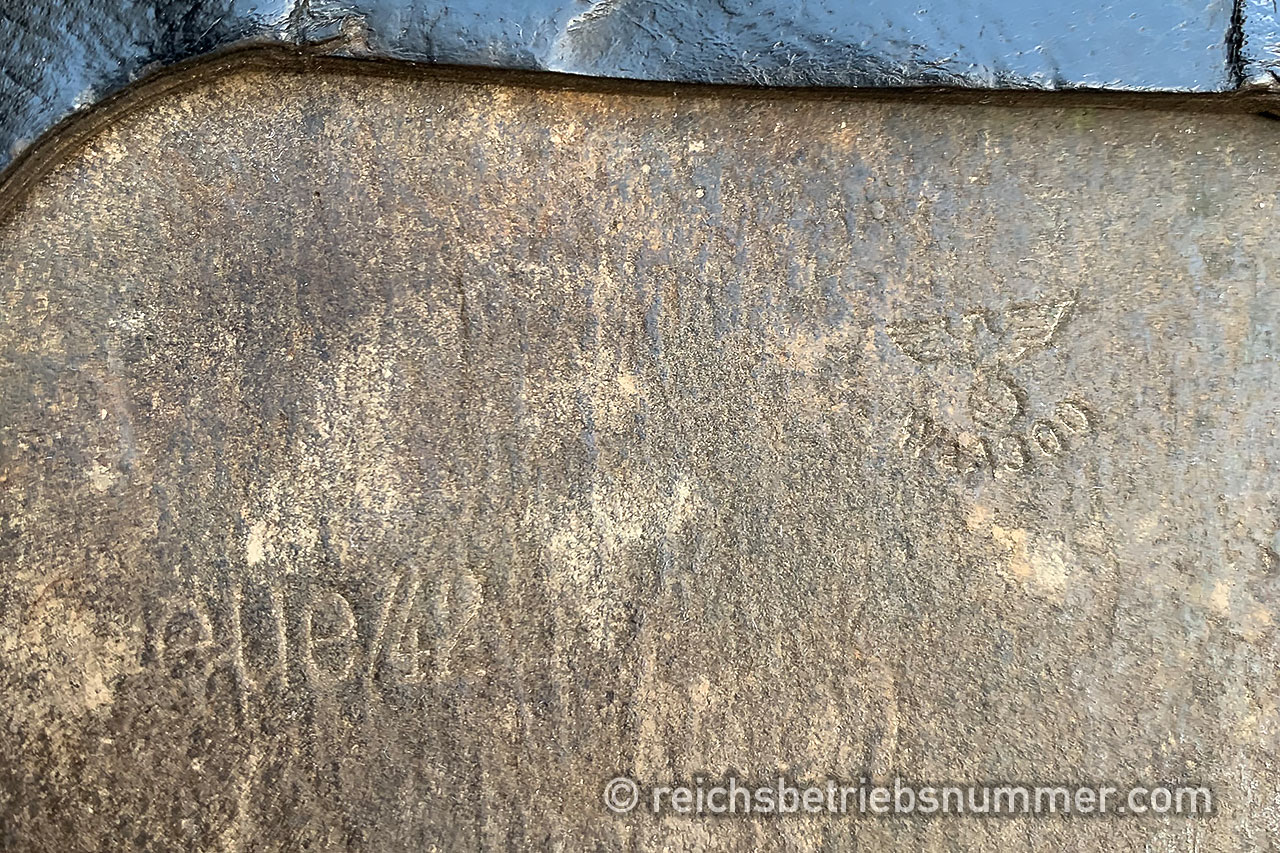
The manufacturer's mark "eue" in the form of a 3-letter code was applied to this 1942 entrenchment tool carrier of the Wehrmacht. The code "eue" stands for the leather goods factory Otto Reichel from Lengefeld. The RBNr. of the company was 0/0384/0011.
Especially in the field of military clothing and equipment, before the beginning of the war and in the first years of the war, the manufacturer's markings were mainly carried out with real names and place. Nevertheless, it can be observed that in the later course of the war, after the introduction of the 3-letter coding, not all producers used it or applied it on all of their products. Real names were still used relatively frequently.
Unfortunately, I do not have any sources that show whether this was actually ordered in this way or whether the companies continued to use their old stamps on their own.
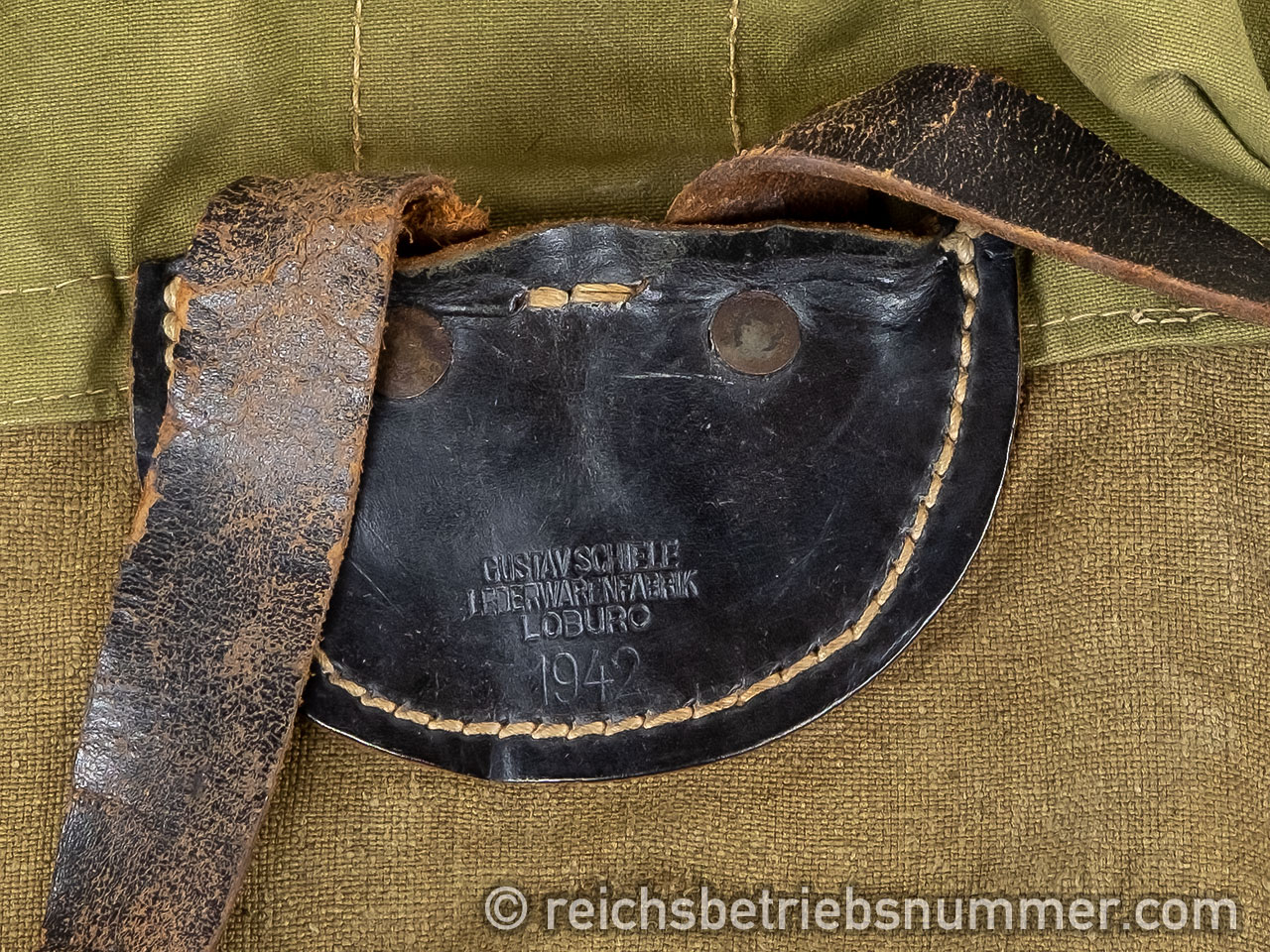
On the back of a so-called artillery backpack produced for the Wehrmacht in 1942, the manufacturer's mark of the Gustav Schiele leather goods factory from Loburg, which was applied with an embossing stamp, is still clearly visible.
However, a significant turnaround was observed in clothing and equipment produced for the Wehrmacht in the course of 1943. The previous form of stamping was mainly replaced by the Reichsbetriebsnummer as a manufacturer's mark. Although the 3-letter code was still used, the marking with real names disappeared almost completely.
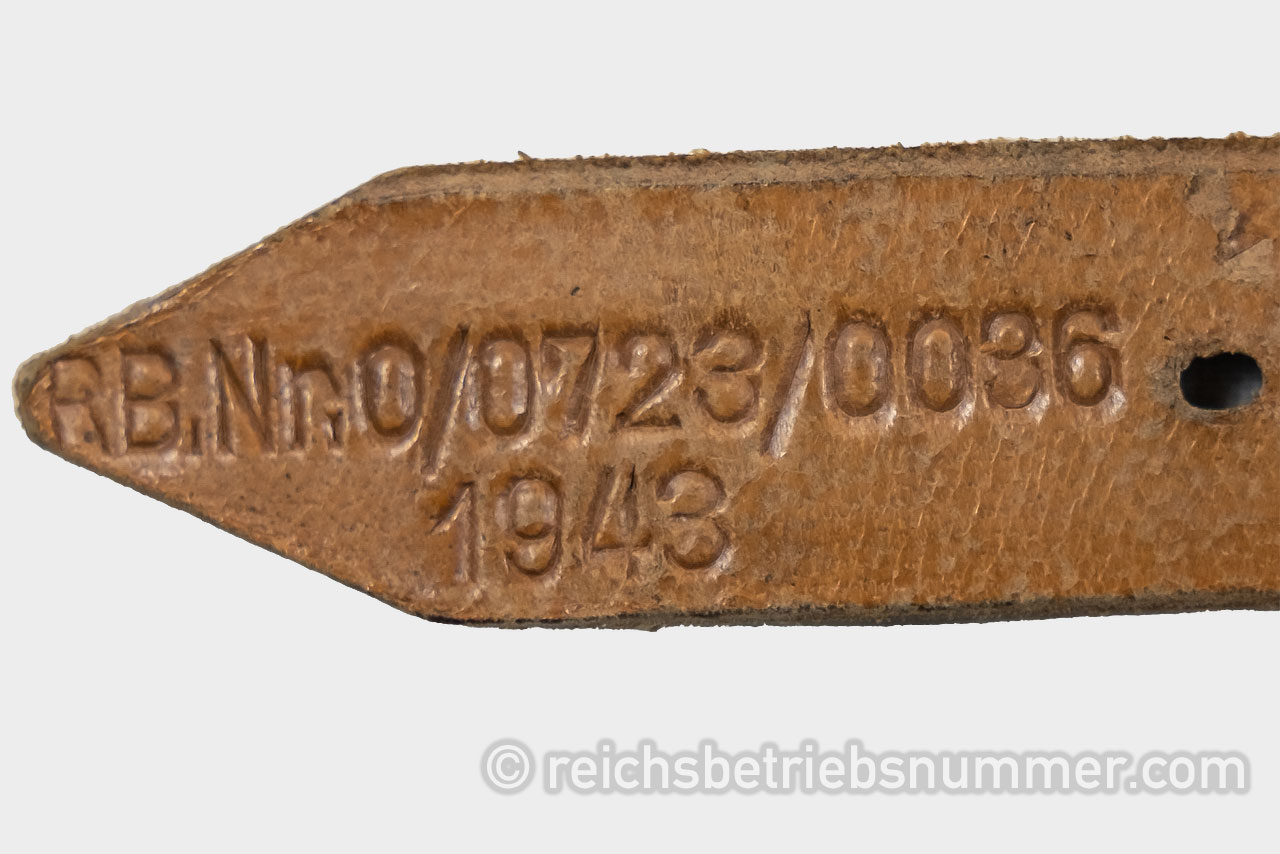
On a equipment strap produced for the Wehrmacht in 1943, the RBNr. 0/0723/0036 was applied as a manufacturer's mark with an embossing stamp. Unfortunately, this manufacturer from the district of Rastatt has not yet been decrypted on the basis of previously available sources. Die Reichsbetriebsnummer als From 1943, in the armaments industries of clothing and equipment,the Reichsbetriebsnummer as a manufacturer's mark replaced the previously used markings with real names almost completely. Also partially the 3-letter coding.
Even if the actual purpose of the Reichsbetriebsnummer is not encryption, or secrecy of armament-relevant companies, by using them as maker markings there was a side effect that made recognition of these companies much more difficult for the opponents..
Reference:
- (1) BARCH, R 11/64
- (2) MARCHIVUM, Stadtwerke (WGE), 6/1964_00044
- (3) BARCH, R 3/19
- (4) BARCH, R 3/513
- (5) H.B.d.d.GmbH
- (6) BARCH, R 3/2015
- (7) BARCH, RH 9/23
- (8) BARCH, R 13 XXII:1150
- (9) BArch, R 3/2008

